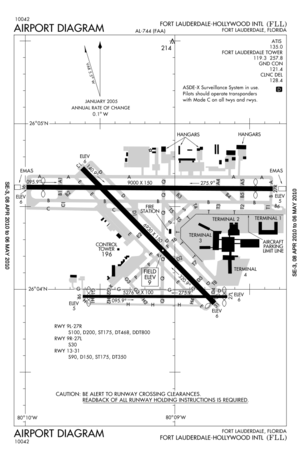The Fort Lauderdale-Hollywood International Airport is the 22nd busiest in the United States- and it’s about to get busier. On Monday, a ground-breaking ceremony was heldat the airport, marking the beginning of a $791 million runway
expansion project. A princely sum, indeed, but the project which will lengthen an existing secondary runway from 5,276 to 8,000 feet, will allow the facility, which served 22 million passengers last year, to handle 27% more flights. The expansion will be technically challenging, rising 65 feet into the air at a slope near the FAA limit, to pass over U.S. 1 and neighboring railroad tracks.
This is a huge price tag, amounting to $36 in cost for each passenger who departs from or arrives at this airport each year. Proponents of the project claim that it will create 11,000 jobs
Using the Regional Input-Output Modeling System (RIMS II) as a basis, the construction is anticipated to generate more than 11,000 jobs over the life of the project. RIMS II multipliers estimate how much a one-time or sustained increase in economic activity in a particular region will be supplied by industries located in the region and used by private and governmental agencies. Additionally, the airport has commenced wetland restoration/mitigation activity at West Lake Park, in Hollywood, Florida, and recently completed the pilot phase of a $170 million noise mitigation program. Beyond the direct economic impact, there are countless additional economic benefits that will be derived by the on-going activity during the construction period.
We have to say, this claim is dubious at best. With Miami International Airport very close by, and other nearby airports such as Palm Beach, it’s not clear how much new traffic this will bring to South Florida. If the project’s return is dependent on 11,000 jobs being created, this is likely a poor use of government funds. Particularly disturbing is the $170 million to be spent on “noise mitigation”. We’re constantly amazed at how people who own property surrounding an airport seem surprised and angered when planes fly over their heads.
It’s par for the course that this huge subsidy for airlines is welcomed by all. We don’t see Governor Rick Scott, who famously refused High-Speed Rail funding, turning away this wasteful spending. For some reason, subsidizing air travel or car travel is acceptable, but trains are a boondoggle and Amtrak ought to make money without subsidies. This will probably make our travels into Fort Lauderdale more pleasant, but only if we don’t think about the extreme cost for a small benefit.
Related articles
- FAA Breaks Ground for Runway Expansion in Fort Lauderdale (athingforcars.com)
- Ground Broken On Runway Project At Ft. Lauderdale’s Airport (miami.cbslocal.com)
- California Man Changes Flight 510 to Flight 420 (flightwisdom.com)
- We’re Expanding in Fort Lauderdale With More Service to San Juan! (jetblue.com)

